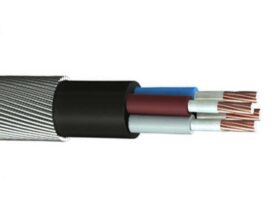PVC (Polyvinyl Chloride) cable and XLPE (Cross-linked Polyethylene) cable are two common types of insulated cables used in various electrical applications. While both types serve similar purposes, there are distinct differences between PVC and XLPE cables. Here are some key differences:
- Insulation Material: PVC Cable: PVC cables have insulation made of PVC, a thermoplastic material. PVC is known for its excellent electrical properties, flexibility, and affordability. It is widely used for low to medium voltage applications.
XLPE Cable: XLPE cables, on the other hand, have insulation made of cross-linked polyethylene. XLPE is a thermoset material that offers superior electrical, thermal, and mechanical properties compared to PVC. It is commonly used for medium to high voltage applications.
- Temperature Rating: PVC Cable: PVC cables have a lower maximum temperature rating compared to XLPE cables. PVC insulation typically has a maximum continuous operating temperature of around 70°C. Beyond this temperature, PVC may start to degrade.
XLPE Cable: XLPE cables have a higher temperature rating, with a typical maximum continuous operating temperature of 90°C or higher. This higher temperature rating makes XLPE cables suitable for applications that involve higher operating temperatures or where thermal stability is crucial.
- Current-Carrying Capacity: XLPE Cable: XLPE cables have a higher current-carrying capacity compared to PVC cables. The cross-linking process in XLPE insulation improves the cable’s ability to handle high current flows without significant power losses. This makes XLPE cables suitable for applications that require the transmission of higher currents.
- Voltage Rating: PVC Cable: PVC cables are commonly used for low to medium voltage applications, typically up to 1 kV (kilovolt).
XLPE Cable: XLPE cables are designed for medium to high voltage applications, typically ranging from 3.3 kV to 33 kV or higher. XLPE insulation provides enhanced electrical properties that allow for reliable operation at higher voltages.
- Resistance to Environmental Factors: PVC Cable: PVC insulation offers good resistance to moisture, chemicals, and sunlight. However, it is more susceptible to degradation over time when exposed to harsh environmental conditions.
XLPE Cable: XLPE insulation provides excellent resistance to moisture, chemicals, and sunlight. It offers better resistance to aging and degradation compared to PVC, making XLPE cables more suitable for outdoor and harsh environments.
- Installation Flexibility: PVC Cable: PVC cables are known for their flexibility, making them easier to handle and install. They can be bent and routed more easily than XLPE cables.
XLPE Cable: XLPE cables are less flexible compared to PVC cables. Due to the cross-linking process, they have a relatively stiffer construction. However, XLPE cables still offer sufficient flexibility for installation in most applications.
In summary, the choice between PVC cable and XLPE cable depends on the specific application requirements, voltage levels, temperature ratings, environmental conditions, and current-carrying capacity needed. PVC cables are commonly used for low to medium voltage applications, while XLPE cables are suitable for medium to high voltage applications that require higher current-carrying capacity and better resistance to environmental factors.
In summary, Relemac Cables is a renowned manufacturer, offering PVC and XLPE cables that meet the highest standards of quality and reliability. Their commitment to innovation and customer satisfaction has solidified their position as a driving force in the wire and cable industry, empowering industries to achieve efficient and sustainable electrical solutions.











Leave a Reply